This post may contain affiliate links, which earn us commission. Learn more.
Here’s our expert picks and detailed comparisons of the best wireless earbuds of 2025, featuring exceptional sound quality, active noise cancellation, superior battery life, and outstanding comfort, all tested by the editor of NerdNet.
Quickly, before we dive in, I wanted to define a term I still see used in earbud marketing: True Wireless Earbuds. They’re the type of earbuds we’ll be taking a look at. So, what exactly are true wireless earbuds? Unlike “traditional” wireless earbuds connected by a cable or neckband (like the Suunto Sonic Bone Conducting Headphones), true wireless earbuds are entirely cord-free, offering maximum convenience and freedom of movement. It’s a distinction that doesn’t seem terribly relavent these days because so few of those “corded” wireless earphones exist. But now you know!
Regarding the earbuds we’re reviewing here, most premium models include advanced active noise cancellation (often styled as “ANC”, “noise canceling” or alternatively “noise cancelling” with a double L). The earbuds highlighted in this list deliver outstanding audio clarity, comfortable ergonomics for prolonged use, robust noise-cancelling capabilities, and impressive voice-call quality.
All of the earbuds currently included are at or under $300 and are generally considered your everyday carry earbuds. Anything priced above that enters “audiophile” territory which we’ll cover in a separate list. Also keep an eye out for sub-$100 earbud and over-ear headphone recommendations. Subscribe to our newsletter so you don’t miss those.
All earbuds have been rigorously tested and this page will be updated with the latest, greatest in wireless earbud technology.
NerdNet Picks
-
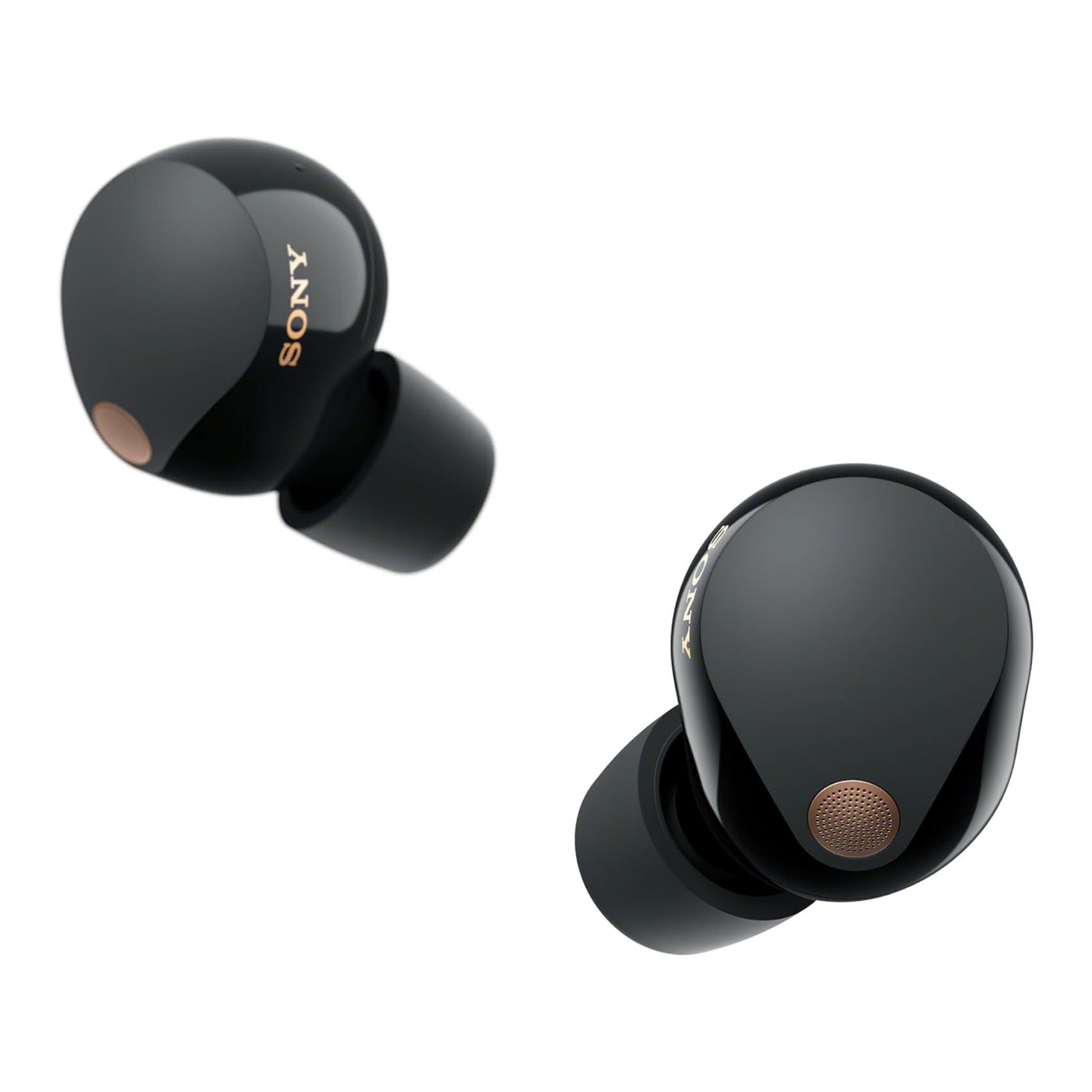
Sony WF-1000XM5
Best Overall | Check Amazon Price | Read Review
-
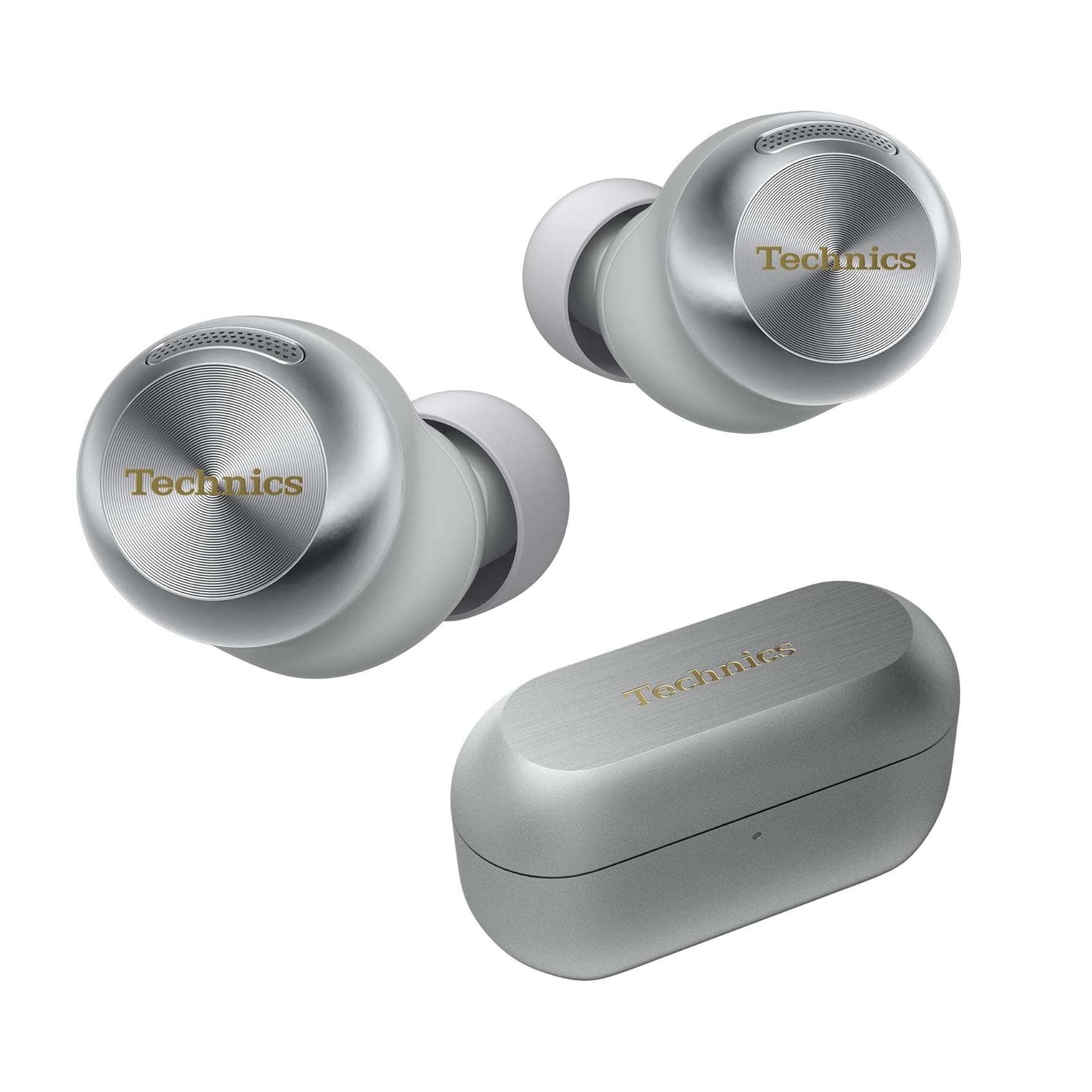
Technics AZ100
Best Sound | Check Amazon Price | Read Review
-

Apple AirPods Pro 2 (USB-C)
Best for Apple Users | Check Amazon Price | Read Review
-
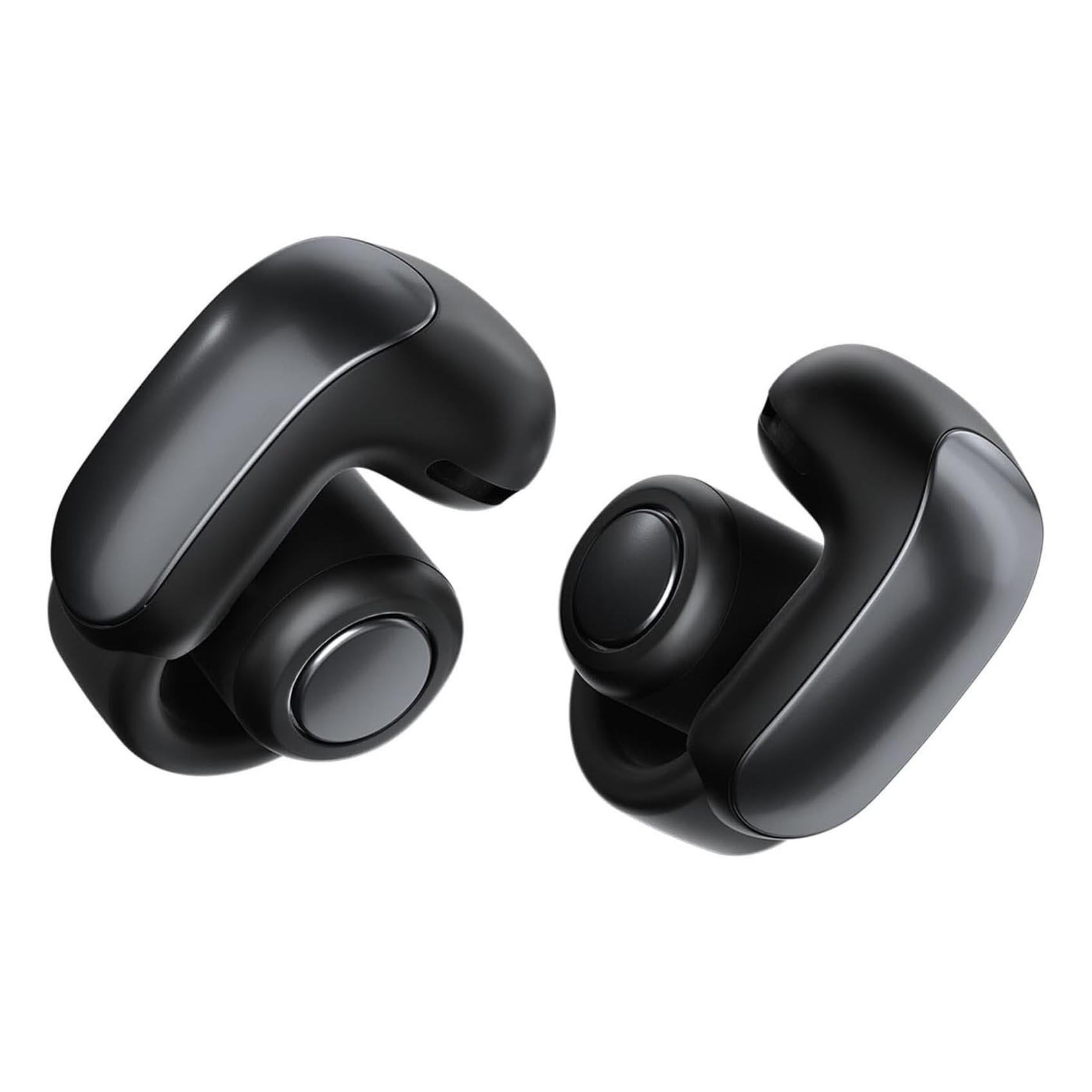
Bose Ultra Open Bluetooth Earbuds
Best Open Ear | Check Amazon Price | Read Review
-
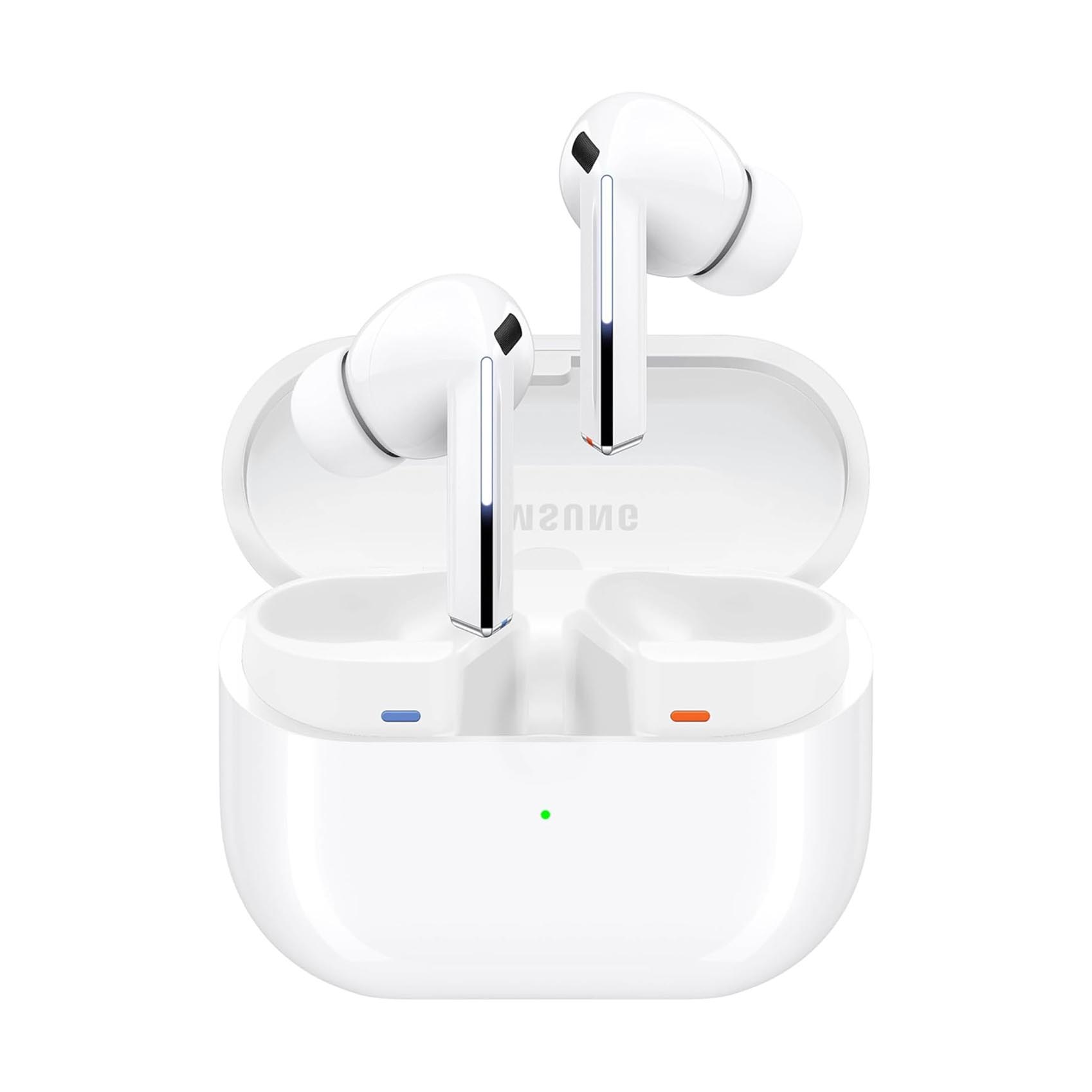
Samsung Galaxy Buds 3 Pro
Best for Android Users | Check Amazon Price | Read Review
-
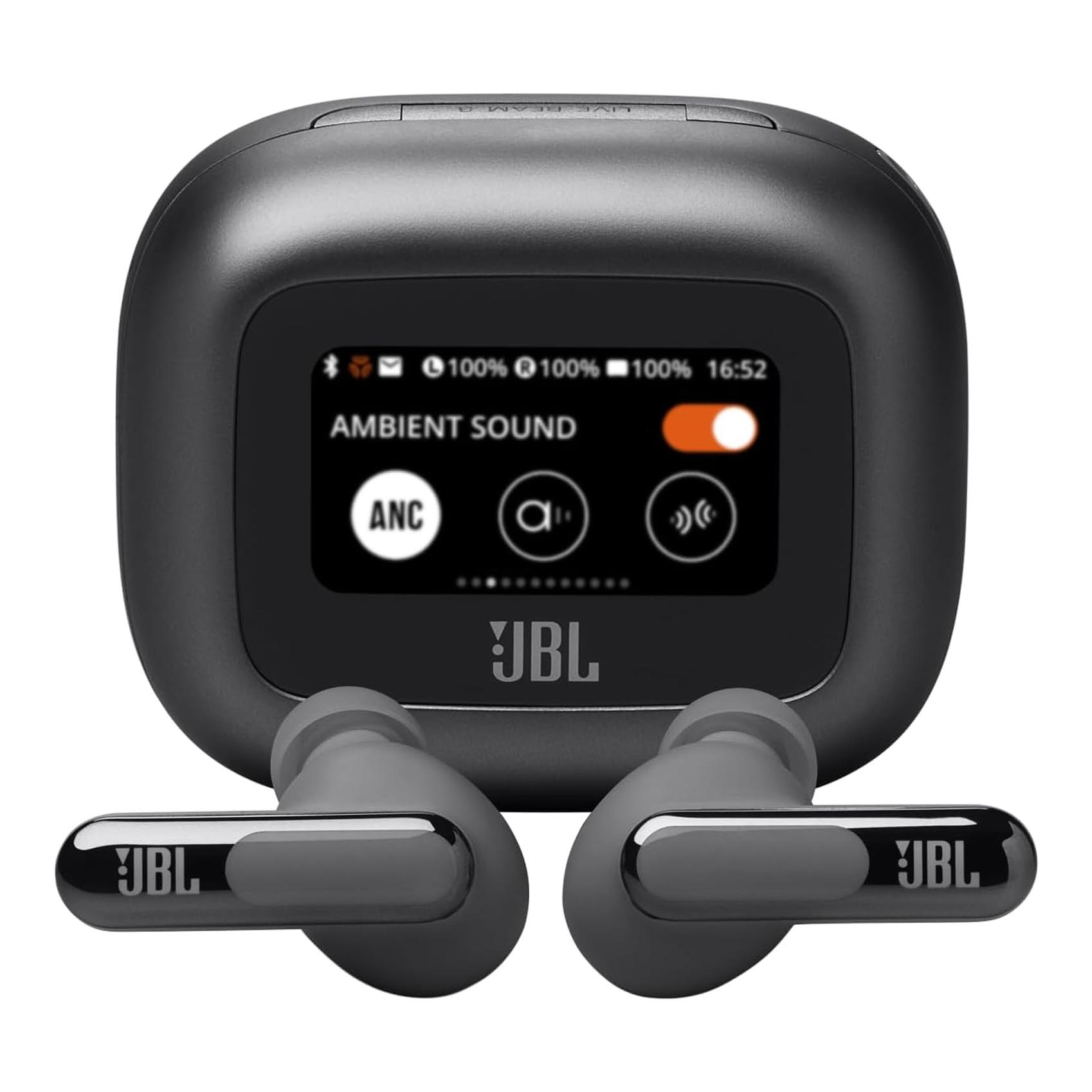
JBL Live Beam 3
Best for Phone-Free Control | Check Amazon Price | Read Review
-
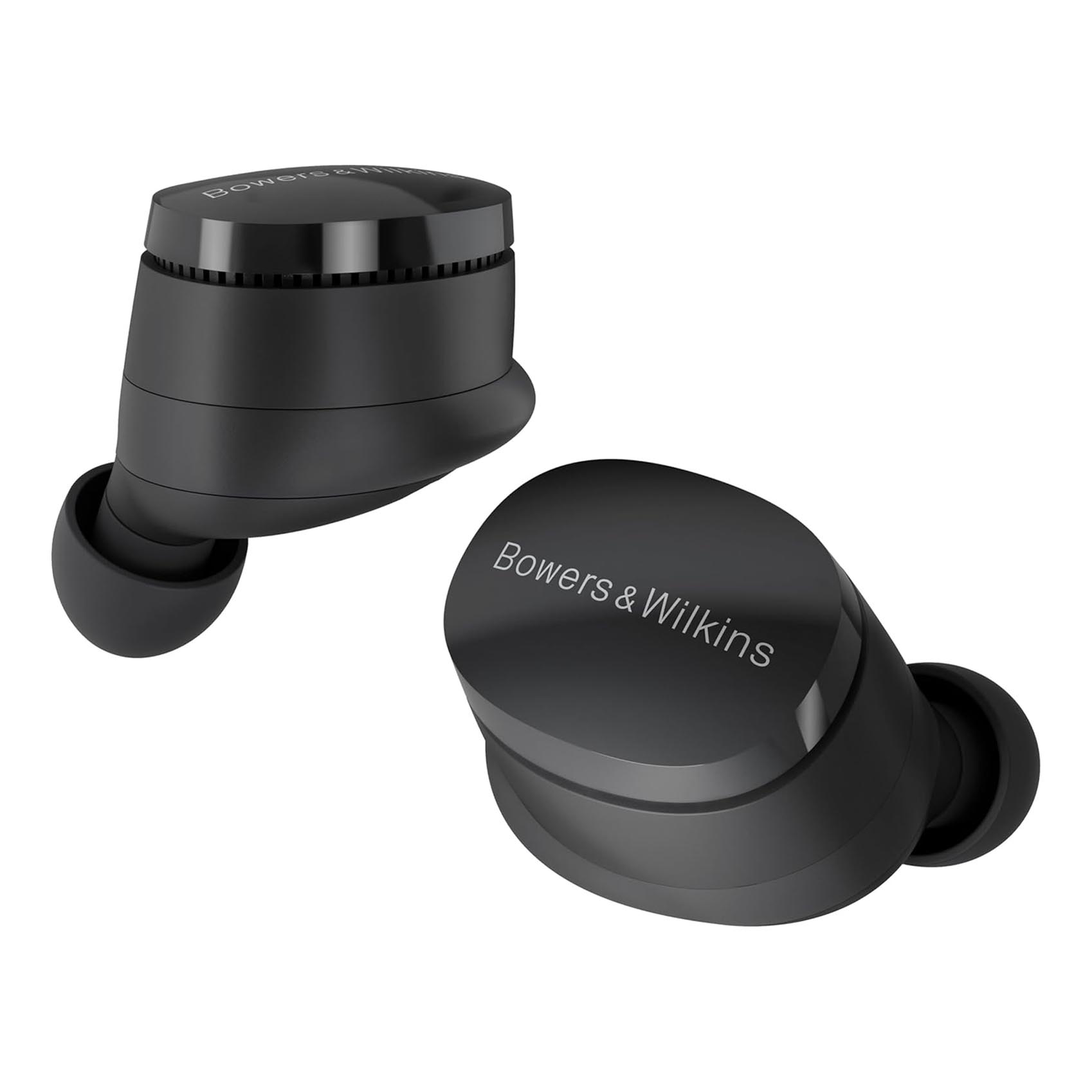
Bowers & Wilkins Pi6 Wireless Earbuds
Most Comfortable Stemless | Check Amazon Price | Read Review
-

Beats Powerbeats Pro 2
Best for Workouts | Check Amazon Price | Read Review
Technics AZ100: Best Sound
NerdNet Verdict
The Technics AZ100 earbuds deliver audiophile-grade sound with rich bass, smooth treble, and superb detail, while offering standout features like LDAC support, triple-device connectivity, and excellent ANC tuned for travel. Though pricey at $299, their comfort, long battery life, and premium build make them ideal for discerning listeners and frequent flyers.
- Audiophile-level sound quality
- Triple-device Bluetooth connectivity
- Long 10-hour battery life
- Expensive at $299
- Voice Focus sounds robotic
- Slight ear canal pressure
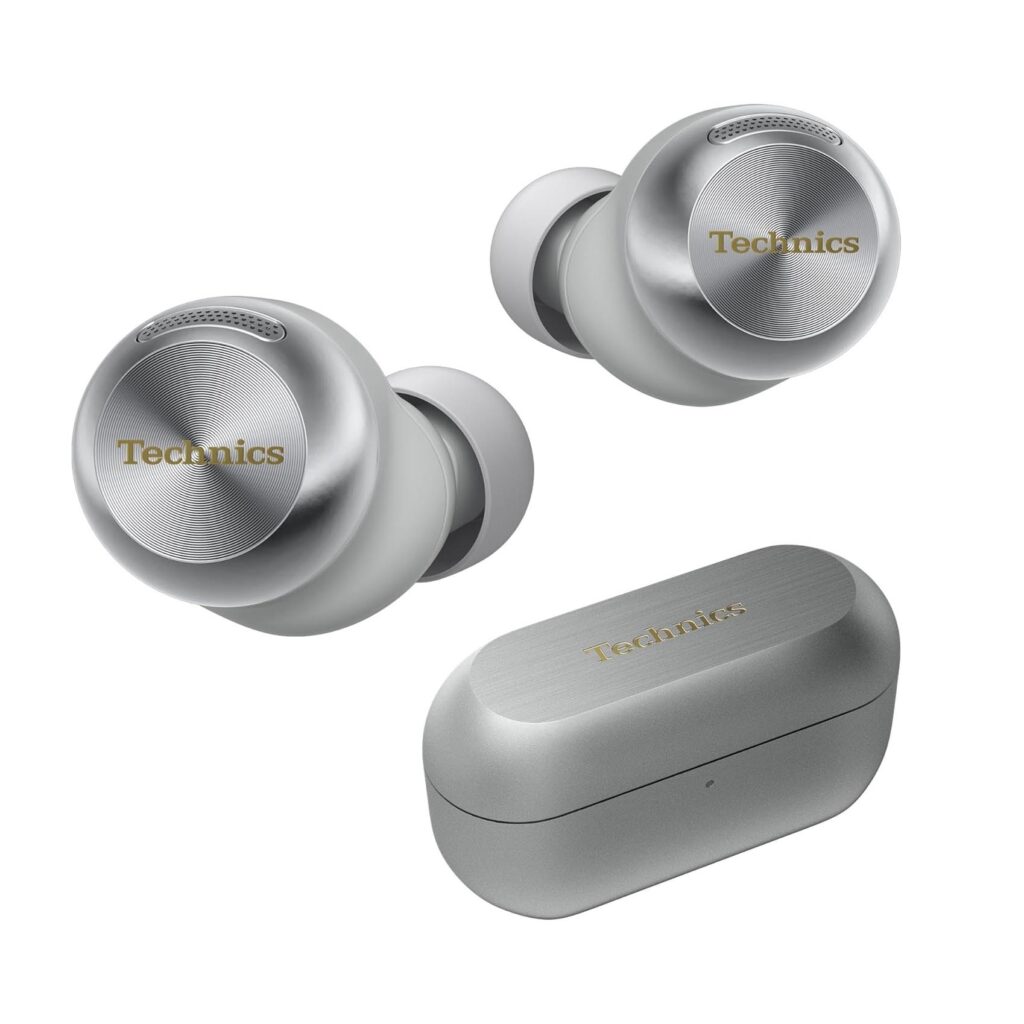
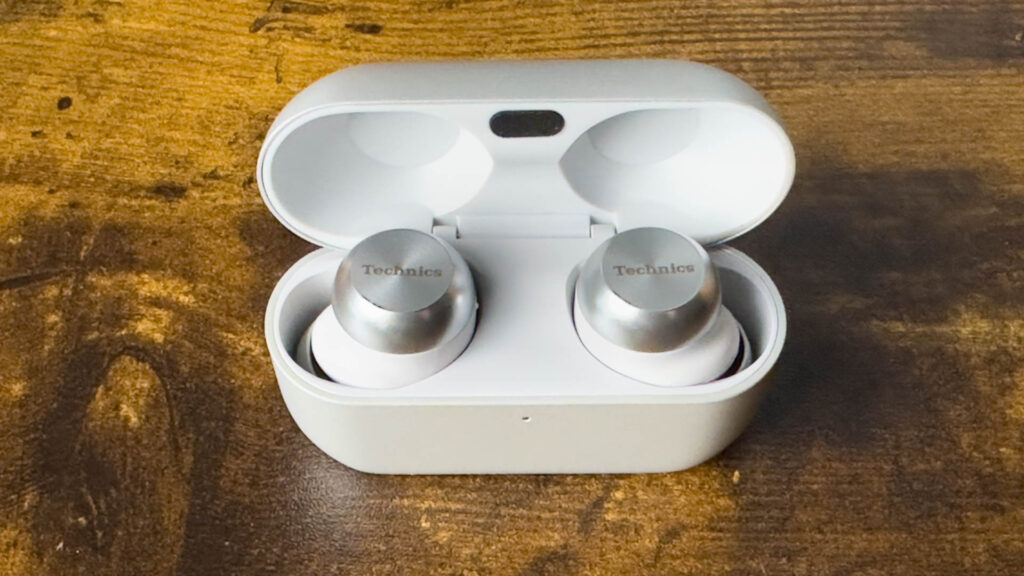
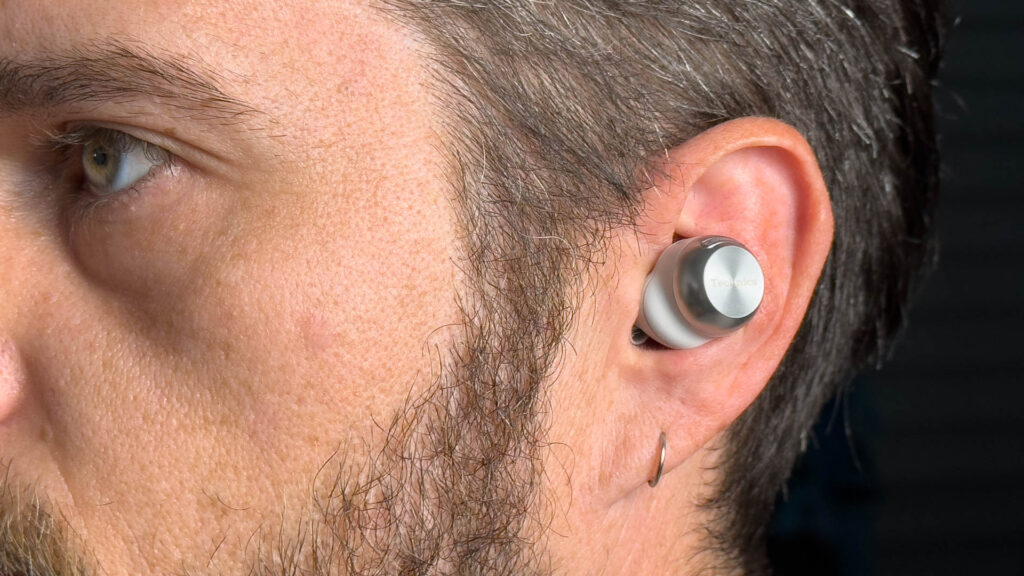
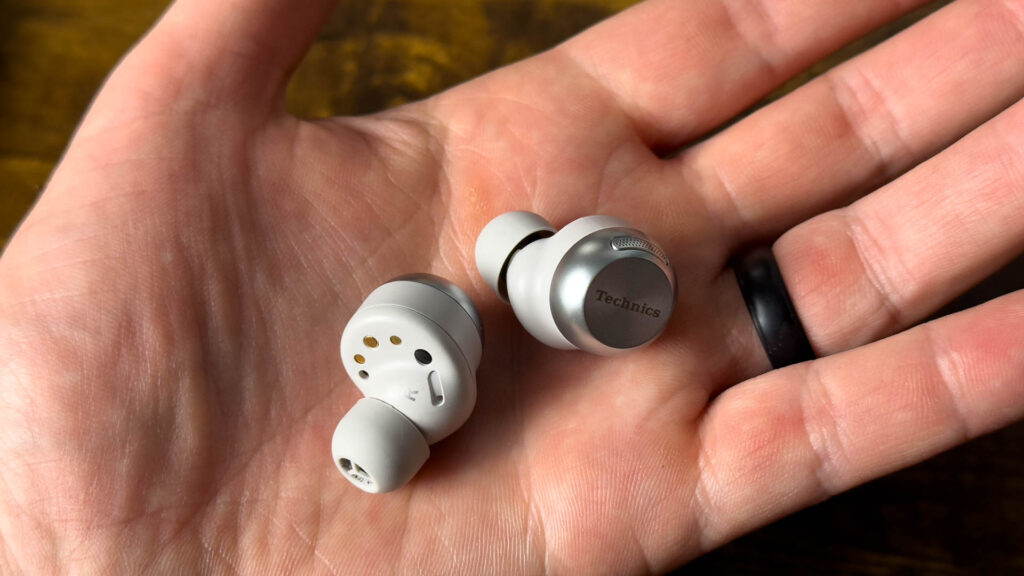
Standout Features: The AZ100 pushes the envelope when it come to audio quality – superb detail and clarity in audio playback, excellent active noise canceling (ANC), and an array of high-end features to satisfy the most demanding listeners. The audio quality and EQ out of the box ease it just over the Sony WF-1000XM5. Technics incorporates magnetic fluid drivers for low-distortion hi-fi sound and support for LDAC high-res audio. The buds feature advanced ANC that, according to various reviewers (we haven’t had the opportunity to fly with these yet) strongly attenuates airplane engine noise for travel. But overall ANC was on par with other earbuds around this price point. These offer the ability to pair with up to three devices simultaneously via Bluetooth (triple-point connectivity) – and in practice works great for seamlessly switching between your phone, laptop, and tablet. There’s also a “Voice Focus” AI mode intended to enhance call clarity by subduing background chatter (though in practice this can make voices sound a bit robotic on the other end).
Sound Quality: The EAH-AZ100 delivers a warm, rich sound with full-bodied bass and smooth treble. You get an audiophile-worthy sound that’s both fun and nuanced – lively bass punches, a big sound, and clean vocals/instrumentation. It’s tuned to please both casual listeners and discerning ears, easily rivaling or besting other premium buds in pure audio fidelity.
Fit & Comfort: These earbuds are slightly smaller and lighter than Technics’ previous model (AZ80) though they are the largest we’ve tested, weighing only ~5.9 g each. The chassis has a rounded shape that sits snugly without causing pressure points, and includes four sizes of silicone eartips for a good seal. They stayed comfortable during long listening sessions, but as with all sealing earbuds you may sense a bit of “ear canal pressure”. They stay secure even during light workouts (IPX4 water resistance means they can handle sweat or rain) and are among the more comfortable premium ANC earbuds we’ve tested.
Battery Life & Case: Battery life is outstanding. You get up to 10 hours per charge and about 28 hours total with the compact charging case. It’s feasible to go multiple days without recharging the case. The USB-C case itself is pocket-friendly and feels solid, with fairly strong magnets to secure the earbuds. It also features wireless charging and a quick 15-minute top-up gives around 1.5–2 hours of play if you’re in a pinch.
Drawbacks: The most notable downside is the premium price ($299), which is justified by its performance but still high for casual users. A minor quirk is the Voice Focus calling mode which can make your voice sound unnatural.
Best Suited For: Audio enthusiasts and power users seeking class leading wireless earbuds. There are more niche audiophile-grade earbuds out there but those are going to cost you even more, making this a great compromise in features, audio quality and price.
Sony WF-1000XM5 – Best Overall Wireless Earbuds
NerdNet Verdict
The Sony WF-1000XM5 earbuds deliver top-tier noise cancellation, excellent sound quality with hi-res LDAC support, and a host of smart features like customizable EQ, multipoint connectivity, and spatial audio. With a sleek, comfortable design and strong battery life, they’re a premium option for discerning listeners, commuters, and travelers alike.
- Best-in-class ANC performance
- Rich, detailed hi-res sound
- Customizable fit and foam tips
- Expensive at full price
- Bass may need EQ tuning
- Fit may take getting used to
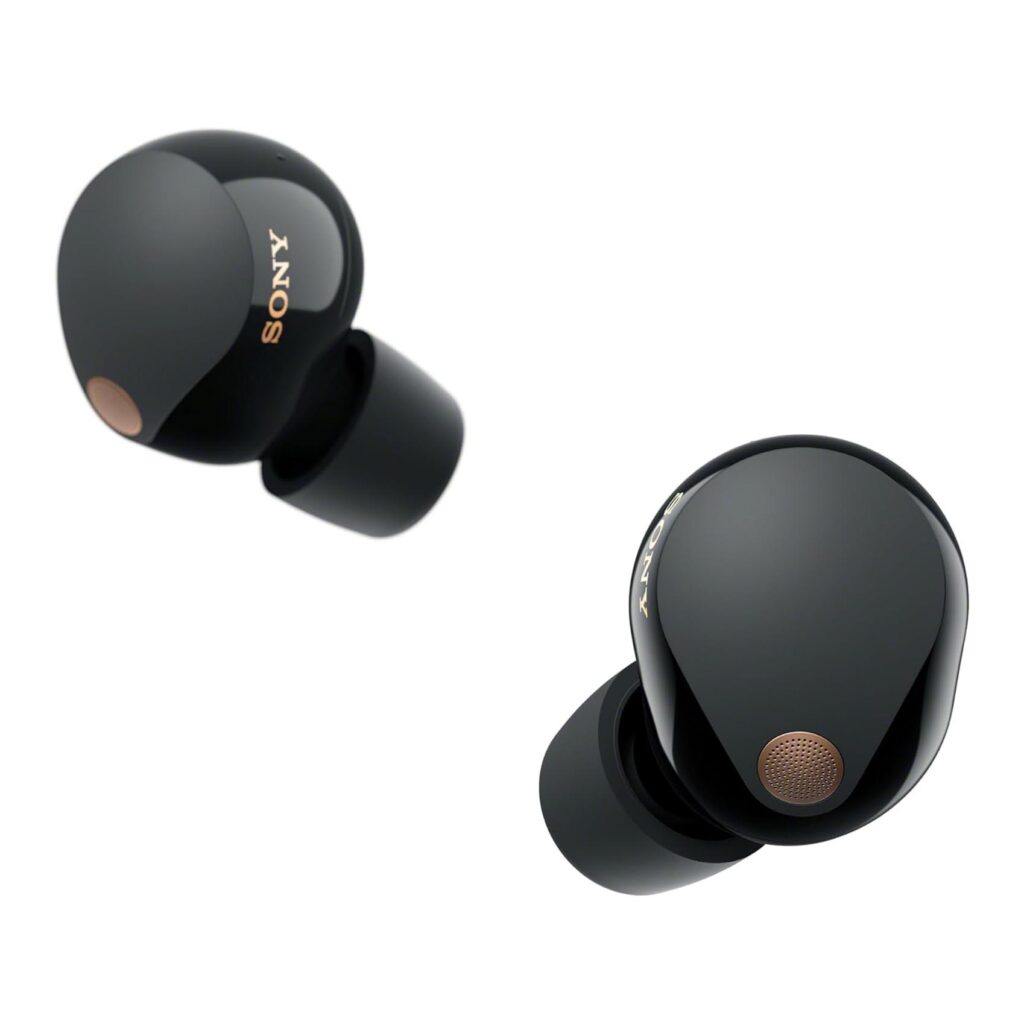
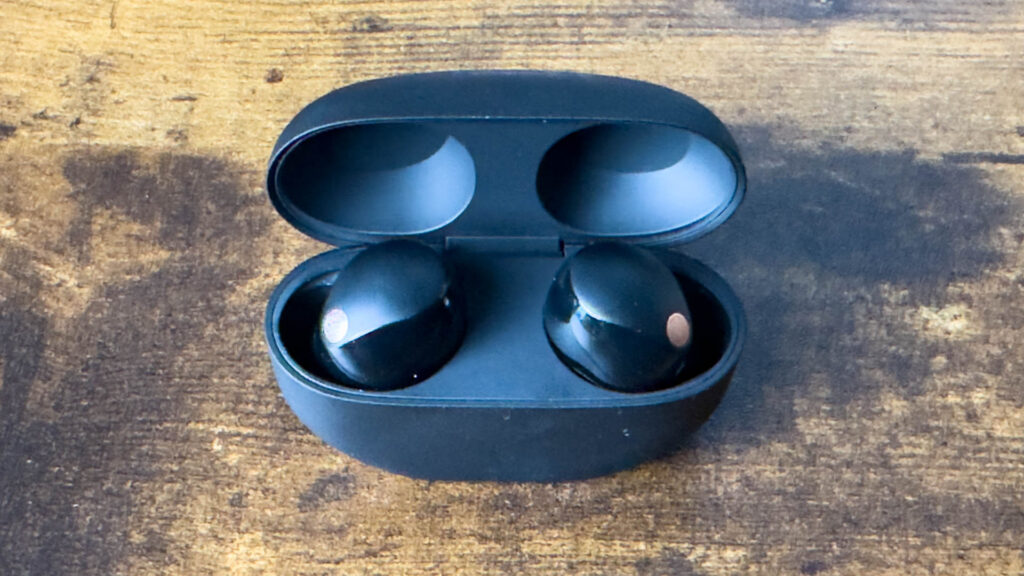
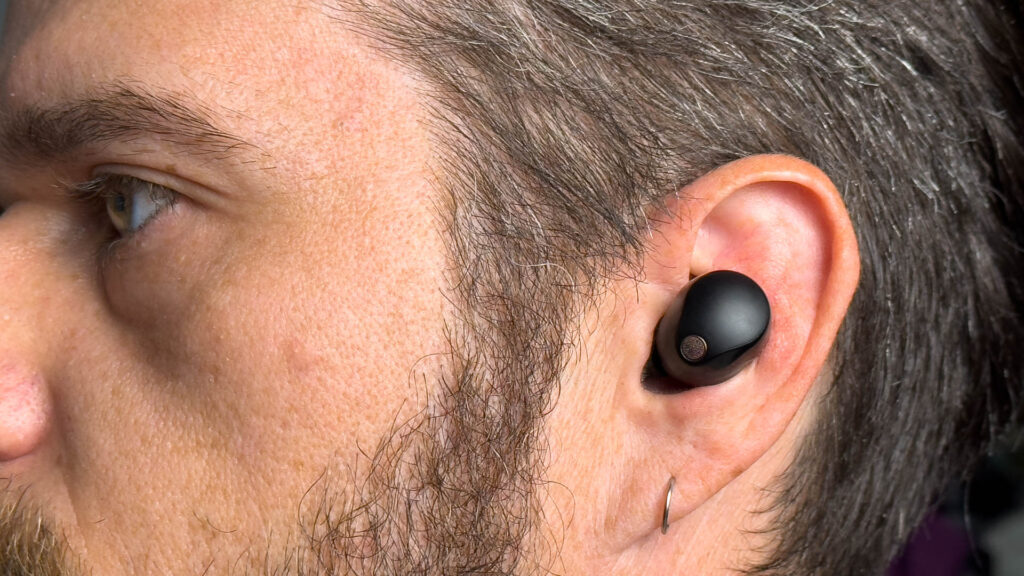

Why It Stands Out: The WF-1000XM5 are packed with Sony’s best tech. They deliver some of the best noise cancellation on the market – slightly better than Bose in our testing – and a sound profile that the most discerning listeners will appreciate. The comfort and fit are greatly improved from older models, has an upgraded processor and drivers, and for Sony fans or anyone seeking a high-end set of earbuds, the WF-1000XM5 has earned their reputation as one of the best noise-cancelling earbuds on the market.
Key Features: The XM5 boasts Dual Processor ANC technology that adapts to your environment, effectively silencing everything from airplane engine rumble to office chatter. They also support Sony’s LDAC codec for hi-res audio over Bluetooth, alongside AAC and SBC, giving audiophiles higher fidelity (on compatible devices, anyway). The inclusion of multipoint connectivity (connecting to multiple devices at once) adds convenience. Sony’s Headphones Connect app allows extensive customization – from a 5-band EQ and sound presets to features like Speak-to-Chat (which auto-pauses music when you talk). Additionally, the XM5 integrates 360 Reality Audio for spatial sound and even has head-tracking for spatial audio. Touch controls on each bud are configurable. The earbuds also have sensors to pause the audio when you remove them from your ears.
Sound Quality: The WF-1000XM5 has class-leading levels of detail and clarity. Out-of-the-box, the low end is rich but not overbearing, mids are natural, and treble is crisp without harshness – an audiophile-friendly tuning that still retains Sony’s signature warmth. If you do prefer extra bass thump, the app’s EQ or “Clear Bass” adjustments can help with that. One of my favorite things about the XM5 is uncovering previous unheard detail in familiar songs that lesser earbuds muddy. The soundstage also feels more open than on many competitors at the same price point. Truly excellent sound.
Fit & Comfort: Unlike many of their competitors, Sony has gone with a foam eartip which conforms to your ear canal for a secure seal (comes with four different size tips, fyi). I found the fit extremely comfortable and they stayed in place well enough for moderate workouts. Because the foam eartip itself is the only thing really holding the earbud in it doesn’t feel as secure as, say, Apple AirPods. They stay put surprisingly well regardless. I’d still go with an ear hook design for running or more intense workouts. The buds are IPX4 water-resistant, so they can survive sweat or rain. Overall Sony has achieved a design that is both comfortable for extended listening and stays put well enough for the daily commute or travel.
Battery & Case: Battery life is impressive – you get about 8 hours and 24 hours with the battery case. The case supports Qi wireless charging as well as fast USB-C charging and a quick 5-minute charge gives you about an hour of listening. Each bud also now has wear sensors for auto-pause when removed, helping conserve battery.
Drawbacks: The main con is the premium price of $299, though you can find it on discount here and there. At full price it’s one of the most expensive in-ear options, yet you’re paying for top-tier performance. For those who don’t like a bass-heavy sound, you may find yourself dropping the low-end in the EQ, though I suspect for those new to this level of audio quality it will be like unlocking a whole new world of sound and you’ll leave the EQ as is. While very comfortable, it’s worth noting that you do need to make sure to push them into your ears fully for security. Otherwise they may slowly work their way out.
Best For: Travelers, commuters, and those who appreciate excellent sound quality. These are an excellent choice for flying with their superb noise cancellation. They’re also a great choice for home or office when you need to focus. They’re also great for office or home use when you need to focus, or for anyone in loud environments. If you’re deep in the Android ecosystem (or use hi-res audio sources), you’ll love the LDAC support and customization. Apple users can also enjoy these (via AAC codec) but might miss system-level integrations of AirPods. In short, if you prioritize ANC performance and audio quality in a comfortable wireless earbud, Sony’s XM5 are a top choice and arguably the best all-around ANC earbuds you can buy in 2025.
Apple AirPods Pro 2 – Best for Apple Users
NerdNet Verdict
The Apple AirPods Pro 2 excel with seamless Apple ecosystem integration, improved ANC and transparency modes, and a well-balanced sound profile tailored for everyday use. While not the best in pure audio fidelity, they offer an unbeatable convenience and user experience for iPhone users.
- Instant pairing with Apple devices
- Adaptive transparency softens loud noises
- Comfortable for all-day wear
- Limited features on Android
- No hi-res audio codec
- Sound tuning is very safe
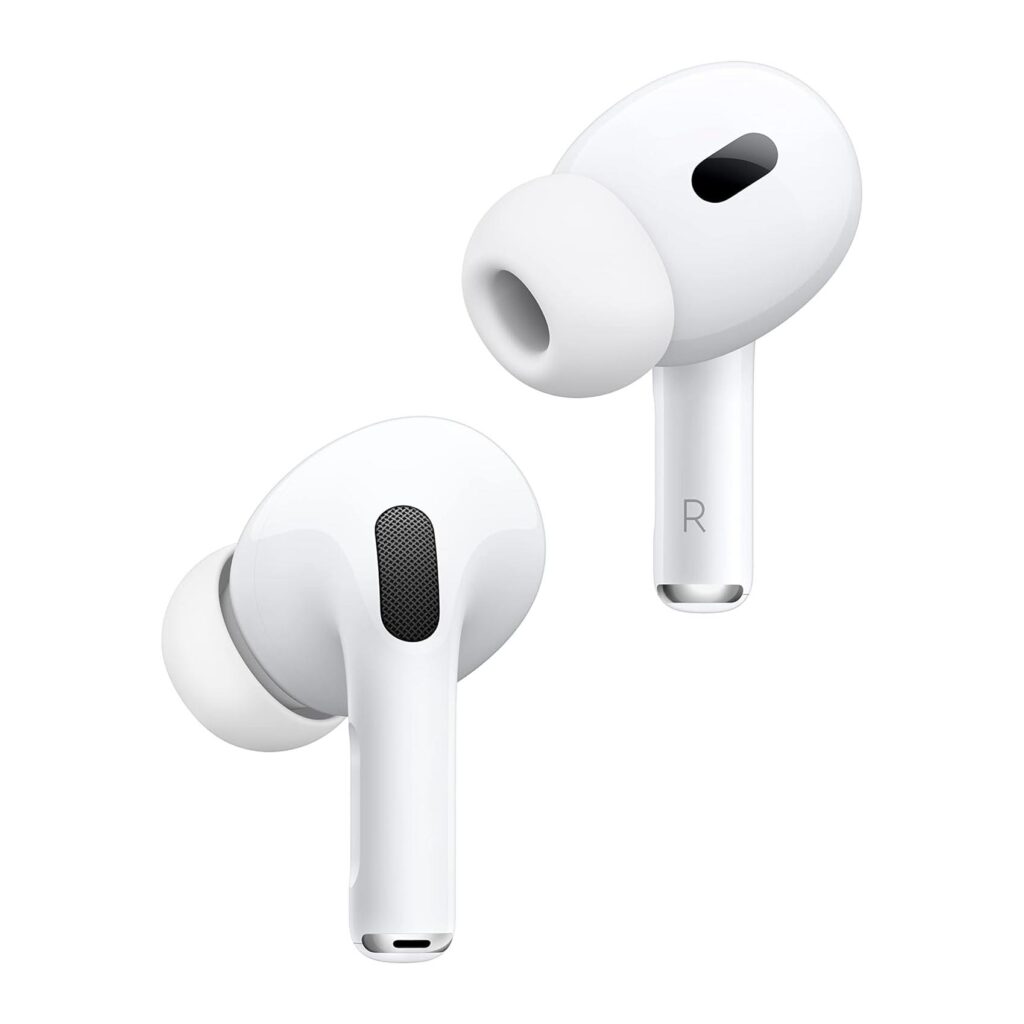
Apple Ecosystem Integration: What makes AirPods Pro 2 shine is how flawlessly they work with Apple devices. Thanks to the H2 chip, pairing is instantaneous and switching between your iPhone, iPad, and Mac is automatic and effortless. Features like Audio Sharing (pair two sets of AirPods or Beats, which is owned by Apple, to one device) and Hands-Free “Hey Siri” voice commands underscore their tight integration. The new U1 chip in the MagSafe charging case enables Precision Find My – your iPhone can lead you directly to the case if it’s lost. The case even has a built-in speaker that plays a sound for location pings or low-battery alerts. All these little Apple-only touches (along with things like automatic device switching and spatial audio personalization) create a user experience that feels almost magic for those in the Apple ecosystem. If you’re an iPhone user, the AirPods Pro 2’s convenience is practically unbeatable – they just work in a way third-party buds often can’t match.
Standout Features: The Adaptive Transparency Mode is a highlight. Apple’s transparency was already the best-in-class, piping in outside sound very naturally; now it can dynamically soften sudden loud noises (like sirens or tools) to protect your ears. It makes walking in a city or chatting in a cafe much more pleasant, as harsh sounds are tamped down while everything else comes through clearly. The AirPods Pro 2 also introduced onboard touch volume control: by lightly swiping the stem, you can raise or lower volume (finally addressing a common request). There’s support for Personalized Spatial Audio: using your iPhone’s TrueDepth camera, you map your ear shape so that Dolby Atmos content can be optimized for you. While spatial audio isn’t exclusive to these AirPods, the ease of use here encourages you to actually use it. Other notable features include Adaptive EQ (the buds auto-tune the sound to your ear fit), and Ear Tip Fit Test to ensure you’ve got a good seal. They’re also sweat- and water-resistant (IPX4 for both buds and case).
Sound Quality: Apple completely redesigned the drivers and amplifiers inside these buds, and the result is the best sound from an AirPod to date. In practice, that means you get a bit more clarity and a little more bass extension compared to the original Pros. The tuning philosophy here aims for a crowd-pleasing balance: nothing is overly boosted or harsh. Overall clarity is improved – you’ll notice that vocals and instruments come through more distinctly than before. The bass has a touch more presence, adding warmth and fullness. High frequencies are crisp, and the mids are natural, which suits all content from music to podcasts. Importantly, nothing stands out as boomy or piercing – it’s a very even sound. The sound is good, but not mind blowing like the Sony MX4’s or Technics 100AZ. They do the job of keeping audio consistently good between genres and media types.
Fit & Comfort: Apple retained the outward design, so the AirPods Pro 2 look and fit very much like the originals. They sit just inside the ear with a short stem – which many will find extremely comfortable, though I do experience some fatigue from them pressing ever so slightly outside the ear canal. And it’s worth noting that if the AirPod shape bothered your ears before, these are the same design. These do include an extra small tip (unlike the previous version) to accommodate those with smaller ears. When properly fitted, the AirPods Pro 2 stay in place for jogging and workouts (and with IPX4 sweat-resistance, they’re gym-friendly), though there are sport-specific buds that lock in even tighter. But the majority of people find they can wear these for hours at a time with zero discomfort. The lack of ear fins or hooks means nothing digs into your ear or outer ear. Overall, Apple hit a great compromise between security and comfort here, suitable for all-day wear.
ANC & Transparency Performance: Apple claims the noise cancellation is twice as effective as effective as the original model. When testing at the gym where there’s crowd noise, the low whir of giant ceiling fans, and music, turning on the ANC was shocking. The outside world just sort of falls away. That’s not to say they’re any better than Bose ANC which is only slightly better. Yes, you can still hear nearby conversations peak through a bit when you’re listening to a podcast or low music, but it’s otherwise fantastic. On the flip side, the Transparency mode remains the gold standard – now augmented by that adaptive feature that softens loud blasts. The transparency is so natural that you might forget you’re wearing earbuds; it’s ideal for situational awareness and conversations. Switching between ANC and Transparency is as easy as a pinch on the stem, and with iOS 17+, you can even have Adaptive Audio that blends ANC and transparency on the fly.
Battery Life: You’ll get around 6 hours of listening with ANC on (up from ~4.5 hours on the original) and about 30 hours total with the case. In real terms, this means the AirPods Pro 2 can easily handle a cross-country flight or a full day of intermittent use without dying. The charging case provides four additional full charges. Charging options are versatile: Lightning port (or USB-C on the very latest revision of the 2nd-gen), MagSafe/Qi wireless, and even Apple Watch chargers can be used. A quick 5-minute charge in the case yields roughly an hour of listening, which is handy. While 6-hour stamina isn’t class-leading, it’s quite respectable – and Apple likely played it safe to avoid sacrificing longevity (battery health) over time.
Drawbacks: For non-Apple users, many of the AirPods Pro 2’s magical features disappear. If you use them with an Android, you won’t have the seamless pairing, spatial audio tuning, or easy firmware updates. There’s also no companion app on Android to adjust settings. So, outside the Apple world, these become more ordinary (albeit still decent-sounding) earbuds. Another limitation is the lack of hi-res codec support – Apple sticks with the standard AAC over Bluetooth. Most casual listeners won’t notice or care, but it’s a consideration if you demand the absolute best wireless audio quality – in which case, you should probably be considering The Sony or Technic’s flagship models. There are plenty of other competitors that edge out over the Pro 2s in audio fidelity and quality around the same price point, too. Apple plays it safe with tuning, which is great for most users, but those who want a very energetic or exceptionally detailed sound might find these a bit conservative. And as always, the $249 price (often on sale for under $200) is on the higher side, though the feature set and integration justify it for many.
Best For: iPhone and Apple device owners who want the most seamless, hassle-free wireless earbuds. If you’re deeply in the Apple ecosystem, the AirPods Pro 2 offer an experience that’s practically tailor-made – from instant pairing to iCloud device switching and spatial audio in Apple Music. They’re ideal for commuters (great ANC), students or professionals (Transparency mode means you can stay aware or have quick chats), and frequent FaceTime/Zoom callers (solid mic quality and hands-free Siri). Fitness enthusiasts will also appreciate the secure fit and sweat resistance, though for very intense workouts some might prefer wing-tip designs. In short, AirPods Pro 2 are best for those who value convenience and balanced performance. They may not win in every individual category (some buds have better pure sound or longer battery), but as an overall package they are incredibly hard to beat. If you’re not a Apple user though, you may want to consider other options.
Bowers & Wilkins Pi6 – Best for Audiophiles
NerdNet Verdict
The Bowers & Wilkins Pi6 deliver a rich, immersive soundstage thanks to dual-driver architecture and 24-bit wireless audio support, all in a stylish and comfortable design. While ANC and call quality lag behind newer competitors, the Pi6 excel in delivering near-audiophile audio for the price.
- Dual drivers for rich, spacious sound
- Supports 24-bit aptX Adaptive audio
- Comfortable, premium fit and finish
- ANC not class-leading
- Limited touch control customization
- Middling call quality in noise

Why It Excels: The Pi6 inherit B&W’s dual-driver architecture—each bud houses a dedicated woofer and tweeter—to produce a spacious, accurate presentation. They cost less yet still deliver a level of clarity and detail that rivals higher-end models. They also offer a true 24-bit audio connection and multipoint connectivity.
Audio Quality: Expect a neutral, transparent signature with punchy bass response, natural mids and crisp highs. Supporting aptX (Advanced and Classic), AAC, and SBC codecs, the Pi6 can render high-resolution streams when paired with compatible Android devices. The low end remains punchy and well-defined enough to satisfy most genres. It’s worth noting that the dual 12mm drivers are made of Bio-cellulose which generally provides a warmer, more dampened sound. That said, when directly comparing them with competitors where audio fidelity is the priority, most tracks sound a bit “muddier” in the mids and lows. Of course, this is a personal preference whether you like a warmer sound or the more precise, analytical performance of something like B&Ws flagship Pi8 with its carbon drivers.
B&W App: I tested the Bowers & Wilkins Music app on iOS. It’s simple with a few key features: change from noise cancellation to pass-through (or off), customize touch controls, update your firmware, connect other B&W products, and link your high-resolution music services in one place. The app features a basic 2-band EQ (treble and bass) which is nice to have but limits how much fine tuning you can do.
Fit & Comfort: The Pi6 feature an ergonomic, slightly elongated shape that sits snugly in the ear. Four sizes of silicone ear tips ensure a secure seal for passive isolation (comes with four sizes), and the relatively lightweight design (just over 6g per bud) makes them comfortable for extended listening. They stay stable during casual movement (think commutes or home use) and light workouts and are IP54 sweat and dust resistance. Unfortunately running was a no-go. Any moderate or heavy activity found these wiggling out of my ears.
Battery Life: On a single charge, the Pi6 last around 7-8 hours with ANC on. The compact charging case adds approximately 24 hours of additional playtime, so for most people (including myself) I would expect to only charge these once a week depending on use. For people who forget to charge and are running out of the house, no worries: a quick 15-minute top-up in the case yields around 2 hours of playback. Forgot to charge the case? They support USB-C fast charging.
Downsides: Compared to newer models, the Pi6’s active noise cancellation is solid but not class-leading. For instance, AirPods Pro 2 cut through crowd noise significantly better. Call performance is adequate but can sound slightly thin in windy or noisy settings. Finally, the $249 MSRP (often discounted to $199) positions them against models with longer battery life or more advanced ANC, so they’re a niche pick for those prioritizing pure sound quality. There aren’t a ton of on-bud touch control options. For example: one preset allows ANC control with the left earbud and voice assitant activation with the right or you can control the volume with the left and right earbuds.
Best For: Dedicated listeners and longtime Bowers & Wilkins fans who want an immersive, near-audiophile experience in a true wireless package without paying top-tier flagship prices. If you have a high-resolution music library or use services like Tidal/MQA and own an aptX Adaptive source, the Pi6 will unlock intricate detail and spatial staging that most buds can’t match-especially at this price point. They’re also suitable for commuters and home listeners who value a full sound over absolute noise suppression.
Bose Ultra Open Earbuds – Best Open-Ear Design
NerdNet Verdict
The Bose Ultra Open Earbuds deliver surprisingly rich audio in an innovative open-ear design that keeps you aware of your surroundings, making them ideal for outdoor activities and office environments. While they lack noise cancellation and come at a premium price, their comfort and spatial audio features make them uniquely appealing.
- Comfortable, pressure-free open-ear fit
- Immersive Audio with head tracking
- Great for outdoor situational awareness
- No noise cancellation at all
- Spatial mode drains battery fast
- Pricey for a niche use case
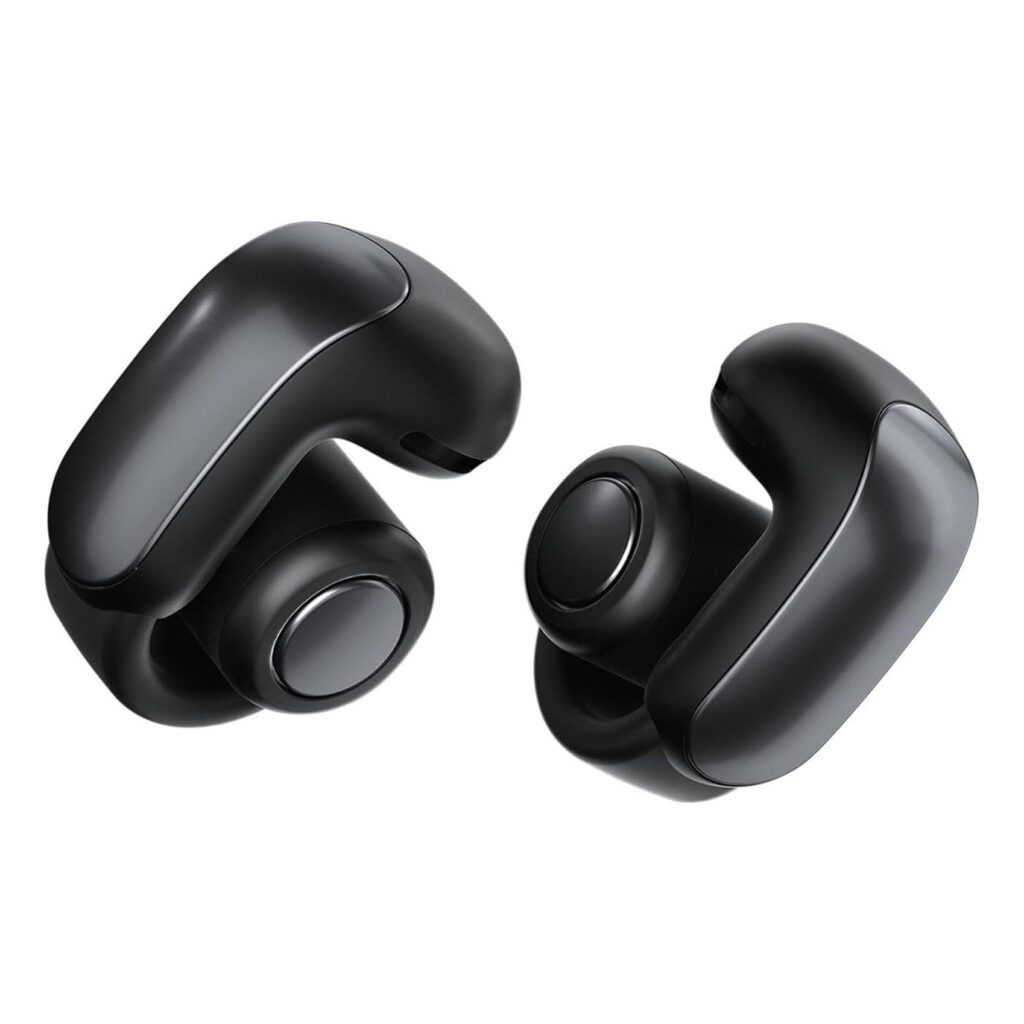
Design & Concept: Over the past few years we’ve started to see more and more of this style – the clip on – which leaves the ear canal open. This means you can still hear ambient sounds and be “aware” of your surroundings without relying on a passthrough mode. Bose calls this OpenAudio technology: you hear your music and the world simultaneously. It’s great for things like cycling, running, the home and office. The earbuds resemble an “ear cuff” that wraps around your outer ear with the driver end sitting just outside the ear canal to direct sound in. They’re lightweight with a flexible “hook” that’s great for people who find traditional earbuds uncomfortable. During testing I almost forgot I was wearing them. It’s a totally different experience from traditional earbuds but despite the lack of isolation provides a stellar listening experience.
Standout Features: Bose packs some cutting-edge features into the Ultra Opens. Notably, these support Bose’s Immersive Audio (spatial audio) modes – a form of personalized virtual surround sound which creates a surprisingly wide soundstage great for streaming and games. They also have motion sensors for head tracking, allowing the sound to stay externally positioned for a more realistic effect when you turn your head. It works so well that I couldn’t believe I wasn’t listening to music from a set of speakers when I turned my head. What’s more, if you have a Bose Smart Soundbar, you can pair the two and basically have your own private surround sound system right in your ears – they even sell the two together as a bundle. One thing I was concerned about was how much sound would leak and be audible to those around me. Surprisingly, most people who I asked said they could barely hear my music, if at all, when in a quiet room. The Ultra Opens also have on-board controls (physical buttons on each bud) for play/pause and to toggle Immersive Audio modes. Lastly, Bose integrated these into their Bose Music app, giving options to adjust EQ, enable/disable spatial audio, and even use a feature that pairs the buds as a wireless microphone for Bose soundbars.
Sound Quality: For open earbuds, the Ultra Opens sound is remarkably full and the best we’ve ever tested. Bose managed to get solid bass and clear highs without a seal – an impressive feat of engineering. You won’t get the same sub-bass rumble as closed in-ears, but it’s still plenty thumpy for pop, rock, or even electronic music, all while hearing the environment. The mids (vocals, guitars) come through naturally, and because your ear is unobstructed, the sound feels like it’s just around you rather than inside your head. The immersive audio makes it seem as though you have mini speakers by your ears which is fantastic for watching live performances. You’re not going to get the same clarity as closed in-ear options in loud environments though, so these are best for moderate to quiet environments. If your priority is awareness, though, they still may be worth it.
Fit & Comfort: These may just be the best choice for those who find most in-ear earbuds uncomfortable. Because of how the cuff sits on your ear, there’s no pressure and no ear fatigue. However, they’re weighted in such a way that makes them feel like they’re going to shake out. But even on moderate runs they stayed put. It’s important to wear them correctly – they clamp on and rotate to a secure position. They are IPX4-rated, meaning sweat or rain is no issue. Also, unlike exercise-specific earbuds with an over-ear loop or hook, these play perfectly well with glasses, making them even more ideal for ocularly-impaired folks like myself.
Battery Life: They offer 7+ hours of continuous play on a charge (at moderate volume). If you enable the Immersive Audio (spatial) mode, battery life reduces to approx. 4 hours, since that processing consumes more power. The charging case provides approx. 19 hours of additional playback (it holds roughly 2-3 additional charges). So total time with case is about 26 hours (which is decent, though not exceptional). The case itself is a bit larger than AirPods Pro’s case, but still pocketable. It does not support wireless charging – you’ll charge via USB-C. A neat stat from Bose: they claim 48 hours of standby on a charge, meaning if you leave them on (connected but not playing audio), they can last two days always ready. And if you do run low, a quick 10-minute charge adds approx. 2 hours of playtime, thanks to fast-charging. So if you forget to charge them, you can always top them off right before you go for that jog.
Drawbacks: It may be difficult to justify $299 (often found for $249) for such a niche set of earbuds. You are paying Bose’s premium for the novel design and tech, but for the same money one could get top ANC earbuds or even decent over-ear headphones. Also, by design, there’s no noise-canceling here – so if you ever do want to block out the world, these simply can’t (they’re the polar opposite of isolation). Forget listening on airplanes or loud commutes. Microphone performance was also less than stellar in noisy areas. It’s acceptable for casual calls, just not a strong suit.
Best Suited For: Runners, cyclists, and outdoor enthusiasts – anyone who needs to hear their surroundings for safety but still wants music. These are perfect for jogs on busy streets or cycling, where being oblivious to traffic is dangerous. Or walkers on busy hike and bike trails that are otherwise oblivious to cyclists passing them. They’re also fantastic for the home or office – still listen to your favorite music, etc. without disturbing the people around you, but still be aware of kids, doorbells, or coworkers. They’re perfect for folks who have sensitive ears or find traditional earbuds uncomfortable. Finally, if you enjoy Spatial Audio or have a Bose soundbar, these are perfect for creating your own personal theater experience. Ultimately, if you’re someone who values comfort and awareness above ground-thumping bass and ANC, these may just be game-changers.
Samsung Galaxy Buds3 Pro – Best for Samsung Users
NerdNet Verdict
The Samsung Galaxy Buds3 Pro are designed for seamless integration across the Galaxy ecosystem, offering smart auto-switching, reliable ANC, and customizable features through the Galaxy Wearable app. With warm, balanced audio and a comfortable fit, they’re ideal for Samsung users who want convenience, clarity, and all-day wearability.
- Seamless switching between Galaxy devices
- Balanced, detailed sound with punchy bass
- Wireless PowerShare from Samsung phones
- Best features require Galaxy ecosystem
- Touch controls can be oversensitive
- ANC falls short of top-tier buds
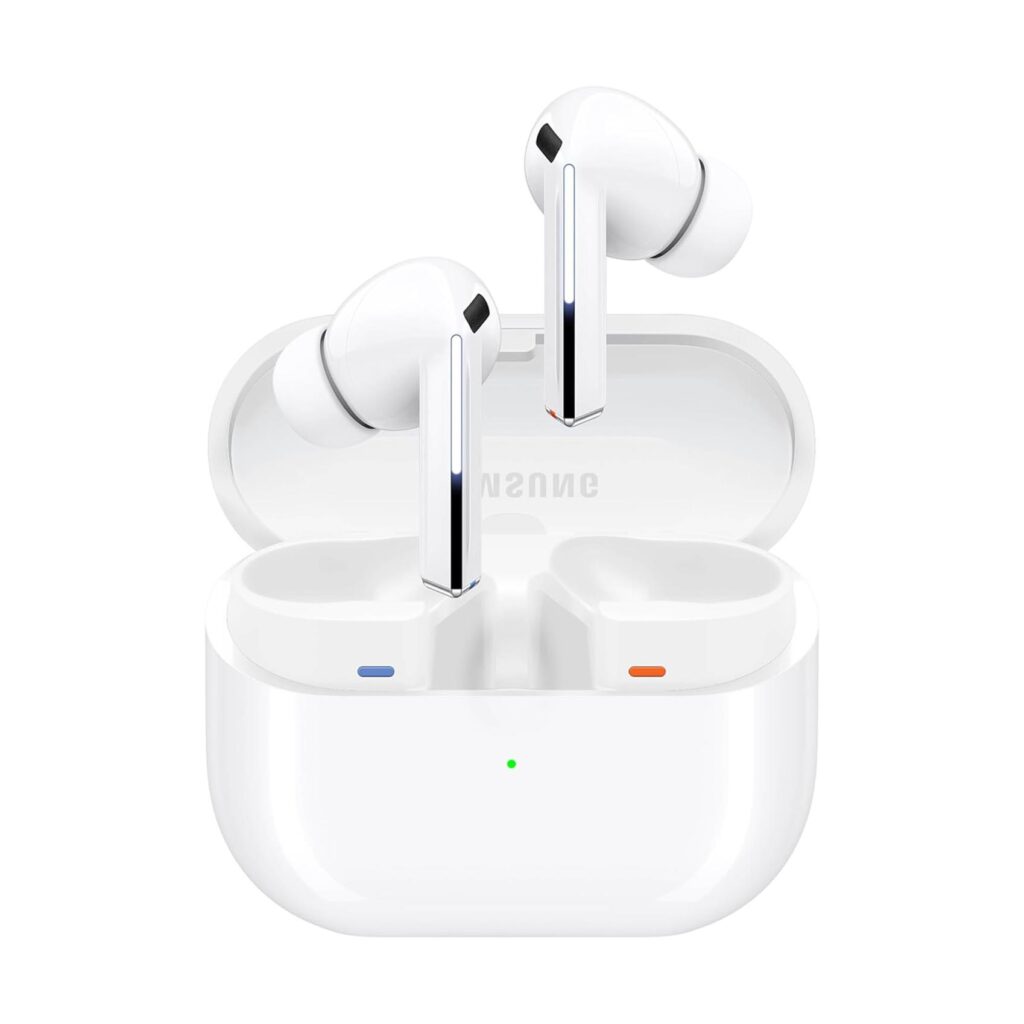
Samsung Galaxy Buds3 Pro – Best for Samsung Users
Why It Excels: Samsung has engineered the Buds3 Pro to feel like a natural extension of its Galaxy lineup. As soon as you open the charging case near any Galaxy phone or tablet, the buds pop up with an instant pairing prompt—no digging through menus required. Once paired, they automatically switch audio sources between your Galaxy smartphone, tablet, or watch when you start playing media on each device. If you’re watching a video on your Galaxy Tab and then pick up your phone for a call, the Buds3 Pro will seamlessly route sound to your phone without a button press. The Galaxy Wearable app further enhances this integration: you can customize touch controls, toggle noise-canceling or ambient modes, and even adjust EQ settings directly from Samsung’s software. For frequent travelers or multilingual households, Galaxy AI brings a standout feature: Real-Time Interpreter and Live Translate. Whether you’re asking for directions abroad or calling in a dinner reservation, spoken language is translated and delivered clearly from your phone to your ears in real time—no typing or app-switching needed. In short, if you own multiple Galaxy devices, these earbuds feel like they were built specifically to make your life easier.
Audio Quality: Under the hood, the Buds3 Pro house Samsung’s third-generation two-way speaker system—one woofer and one tweeter per earbud—tuned to deliver a warm, balanced presentation. Low frequencies have enough heft to provide punchy bass without overwhelming the rest of the spectrum, mids remain clean and intelligible for vocals and podcasts, and the highs come through with crisp detail. When you engage Active Noise Cancellation (ANC), the system employs dual microphones—one inside the ear canal and one outside—to analyze ambient noise and cancel it out. Even with ANC on, musical nuances like subtle guitar strings or soft vocal inflections remain audible rather than getting flattened. Call quality is impressively clear too; Samsung’s improved voice pickup technology filters out background chatter so listeners on the other end hear you distinctly, whether you’re walking down a busy street or in a wind-swept park. While the noise cancellation is strong enough to hush most office chatter and road noise, it doesn’t quite reach the same level of isolation you’d get from Sony’s WF-1000XM5 or Technics AZ100. Still, for everyday use—commuting, coffee shops, or home offices—the Buds3 Pro’s ANC does a trustworthy job.
Fit & Comfort: Samsung refined the Buds3 Pro’s shape to nestle comfortably in a wide variety of ear canals. The stem is shorter and more tapered than previous Buds models, which reduces noticeable protrusion and gives a sleeker, more discreet appearance. You get four sizes of soft silicone eartips—XS to L—to help find a snug seal. In my experience, they felt gentler against the ear canal compared to the firmer tips on Apple’s AirPods Pro 2, which sometimes created pressure after long sessions. The low-profile design also makes them a better fit when wearing glasses, as the stem doesn’t push against the temples. Additionally, an internal pressure relief vent helps avoid that plugged-up feeling over time. Though they lack any rubber fins or hooks, these buds stay secure through moderate movement—jogging or quick gym sets pose no problem. Their IPX7 water resistance rating means they can survive a sweaty workout or an unexpected rain shower. Overall, the Buds3 Pro strike a nice balance: they’re lightweight enough for all-day wear, yet stable enough for most active pursuits.
Battery Life: On a single full charge with noise cancellation activated, the Buds3 Pro sustain roughly 6 hours of continuous playback. Switch to Ambient mode (which lets external sounds in), and that stretch extends to around 8 hours. The compact charging case provides about 28 hours of additional listening time. In practice, this means you could leave home with fully powered earbuds, run a half-marathon playlist, go about your day, and still have enough charge left in the case to top them off several times. Samsung also supports wireless PowerShare: if you place the Buds3 Pro’s case on the back of a compatible Galaxy phone (S21 and newer), the phone’s battery will transfer power to the case—handy if you’re away from outlets. When you do plug in, a quick 5-minute charge inside the case yields about 1 hour of playback, which is ideal for a fast morning commute or short workout.
Downsides: Most of the Buds3 Pro’s signature features hinge on Samsung software. If you pair them with a non-Galaxy Android phone or any iOS device, you lose instant pop-up pairing, seamless device switching, and in-depth customization via the Galaxy Wearable app. Touch controls can feel overly sensitive—accidental double-taps or swipes sometimes occur if you adjust the buds in your ears, which leads to unintended track skips or volume changes. While ANC is very capable, it still lets in faint engine or construction noise that top-tier models (Sony WF-1000XM5, Technics AZ100) block out more completely. Finally, although battery life is solid for daily use, some competing buds now push 8–10 hours of ANC-enabled playtime, so endurance isn’t class-leading. Live translation is useful in limited scenarios.
Best For: If your daily routine revolves around Samsung hardware—whether that’s a Galaxy S or Z series phone, a Tab, a Watch, or even a Samsung TV—the Galaxy Buds3 Pro are tailor-made. They feel like an extension of Samsung’s ecosystem: pairing is automatic, switching from phone video calls to tablet movies happens without a hitch, and in-app controls let you tweak noise-cancellation levels, customize equalization, and manage ANC/Ambient modes seamlessly. For Galaxy owners prioritizing convenience over absolute noise isolation, these earbuds deliver a plug-and-play experience with reliable ANC, intuitive on-ear controls, and long-lasting battery life.
Beats Powerbeats Pro 2 – Best for Workouts
NerdNet Verdict
The Powerbeats Pro 2 are purpose-built for fitness, featuring secure over-ear hooks, long battery life, and workout-ready durability. With balanced sound, physical controls, and Apple ecosystem perks, they’re a near-perfect match for athletes and active users.
- Ultra-secure earhook fit for workouts
- 10-hour battery per charge
- Physical buttons work with sweaty hands
- Bulky charging case
- Earhooks may clash with glasses
- Fewer features than AirPods Pro 2
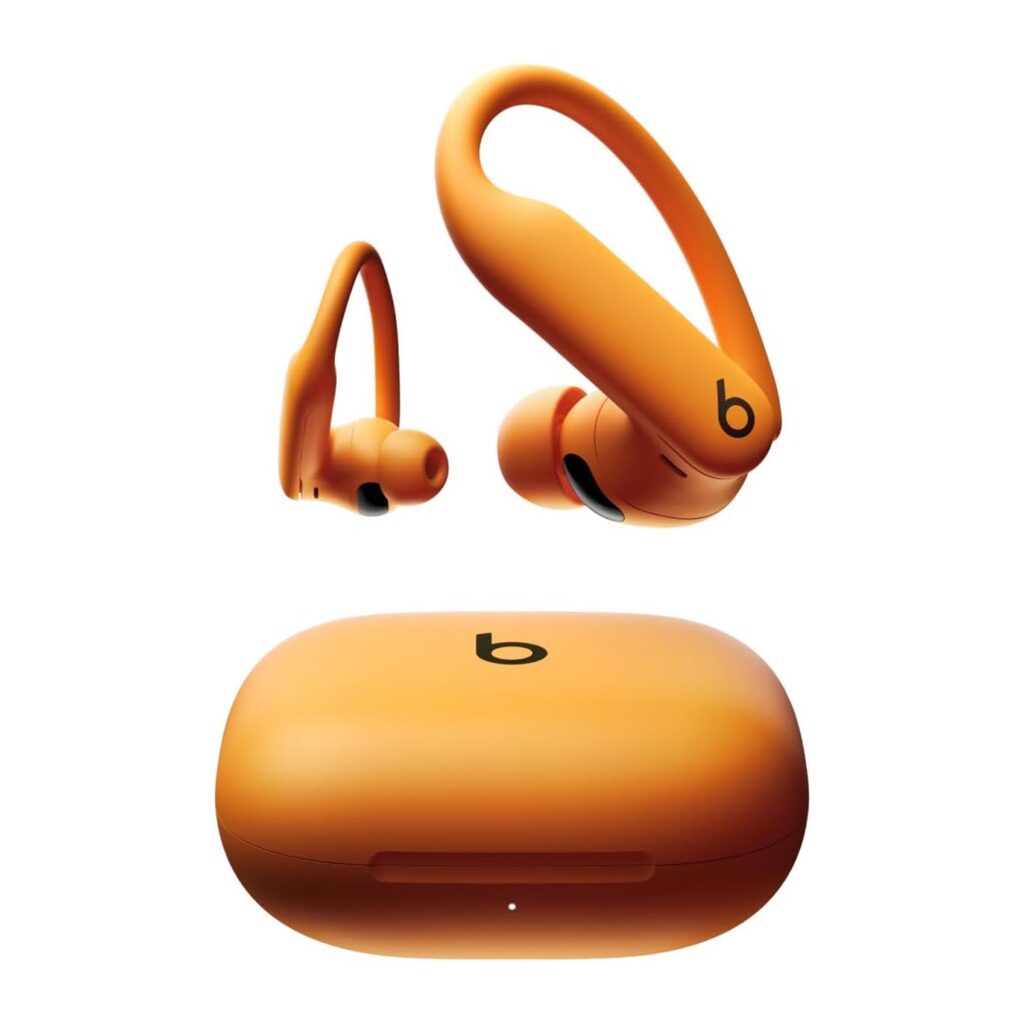
Why It Excels: The defining feature of the Powerbeats Pro 2 is the around-the-ear hook for each earbud. This design practically guarantees the buds won’t budge during vigorous activity. You hook them over your ears, insert the buds, and they stay locked in place through sprints, burpees, jumping jacks – you name it. You now have ANC, transparency mode, Adaptive EQ, personalized Spatial Audio, even a heart rate monitor (which can be disabled). If you wear glasses or a cap, the hooks usually coexist fine (though over-ear sunglasses + earhooks can be a tight combo). The fit is so secure that stability is virtually 10/10 – one reason these have been a staple in the fitness community since the first version’s release.
Rugged and Workout-Ready: Beats built the Powerbeats Pro 2 with workouts in mind. They have an IPX4 sweat and water resistance, so they handle sweat, rain, and even the occasional accidental splash with no trouble. Worried about the ear hooks wearing out and breaking? They’re nickel-titanium alloy–reinforced! Another convenience: each earbud has physical controls, including volume rockers and a multi-function ‘b’ button on each side. With sweaty hands, physical buttons are more reliable than touch sensors. Importantly, the connectivity is rock solid (Class 1 Bluetooth via Apple’s H2 chip gives extended range) so you can practically walk across the gym from your phone without issue. For iPhone users, the H2 chip also enables that magical instant pairing and device switching like AirPods – plus hands-free “Hey Siri” if you want to change music or check messages by voice. One stand out feature of the Pro 2 is the hedrtrate monitor which works with compatible apps on iOS and Android so you can track your fitness levels during a workout.
Sound Profile: Beats has a reputation for big bass but (under Apple’s umbrella) these have been tuned for a more neutral sound (think AirPods Pro 2), and seem fairly well-balanced across bass, mids, and treble. It’s not audiophile tier sound, but then again that’s not really the audience here. One thing’s for sure: the Powerbeats Pro can get loud if you want, and because they have an earhook holding them in place, you can move vigorously without the seal loosening and losing bass (a common problem with other earbuds).
Battery Life: One of the best aspects of the Powerbeats Pro 2 is the class-leading battery life. The earbuds themselves can last up to 10 hours on a single charge – an exceptionally high figure for true wireless. This means even marathon runners or triathletes can likely get through their event on one charge (if you’re into music while you’re competing). For most of us, it translates to perhaps a week’s worth of workouts before needing to recharge the buds. With the charging case, you get over 24 hours of total listening time (the case carries roughly two additional full charges). This is far beyond most ANC earbuds (which hover around 5-6 hours per charge).This latest version adds wireless charging and USB-C. Additionally, there’s a Fast Fuel feature: around 5 minutes of case charging gives 1.5 hours of playback – perfect if you forget to charge and need a quick boost before a workout.
Downsides: The case for the Powerbeats Pro 2 is quite large – significantly bigger than AirPods’ or most earbuds’ cases (though smaller than the first gen). It won’t slip into a tight jeans pocket easily; it’s more of a bag or jacket-pocket item. The size is a consequence of accommodating those earhooks. However, given the long battery, you might not carry the case with you on a run anyway – you can confidently leave it in the car or at home. They may also cause some problems for glasses or goggle wearers simply because of the hook design. Personally, I found the arms of my glasses went behind the hooks without any discomfort. Glasses comfort is probably going to depend on the size and shape of your ears. Even though they’re essentially beefed up AirPods Pro 2’s, they lack some of the advanced features and integrations.
Best Suited For: Athletes, gym-goers, and runners – anyone who needs maximum stability and long battery life in their earbuds. If you do high-impact training, sprinting, CrossFit, or simply have had other earbuds fall out in the past, the Powerbeats Pro 2 will be a reliable partner. They’re especially great for people in the Apple ecosystem who want that AirPods-like easy pairing but with a rugged twist for exercise. They do have an Android specific Beats app, so they’ll work perfectly fine even if you’re not on iOS, you just lose a bit of the seamless integration. The large buttons and sweatproof design make them ideal if you’re frequently adjusting volume or swapping tracks mid-workout – no fumbling with your phone. They’re also a top pick for folks who travel or hike and want long battery – you can go on a long hike or two gym sessions a day without worrying about charging. For all the fitness centered earbuds out there, the Beats Powerbeats Pro 2 just do it better and will likely reign supreme for years to come.
JBL Live Beam 3 – Best for Phone-Free Control
NerdNet Verdict
The JBL Live Beam 3 stands out with a unique touchscreen Smart Case, letting you control volume, ANC, playback, and more without your phone. With excellent battery life, customizable sound, and multipoint Bluetooth, they’re built for power users who want full control on the go.
- Touchscreen case controls everything
- 48-hour total battery life
- Bluetooth multipoint for two devices
- Case is a bit bulky
- Touchscreen can be finicky
- Feature-rich interface may overwhelm
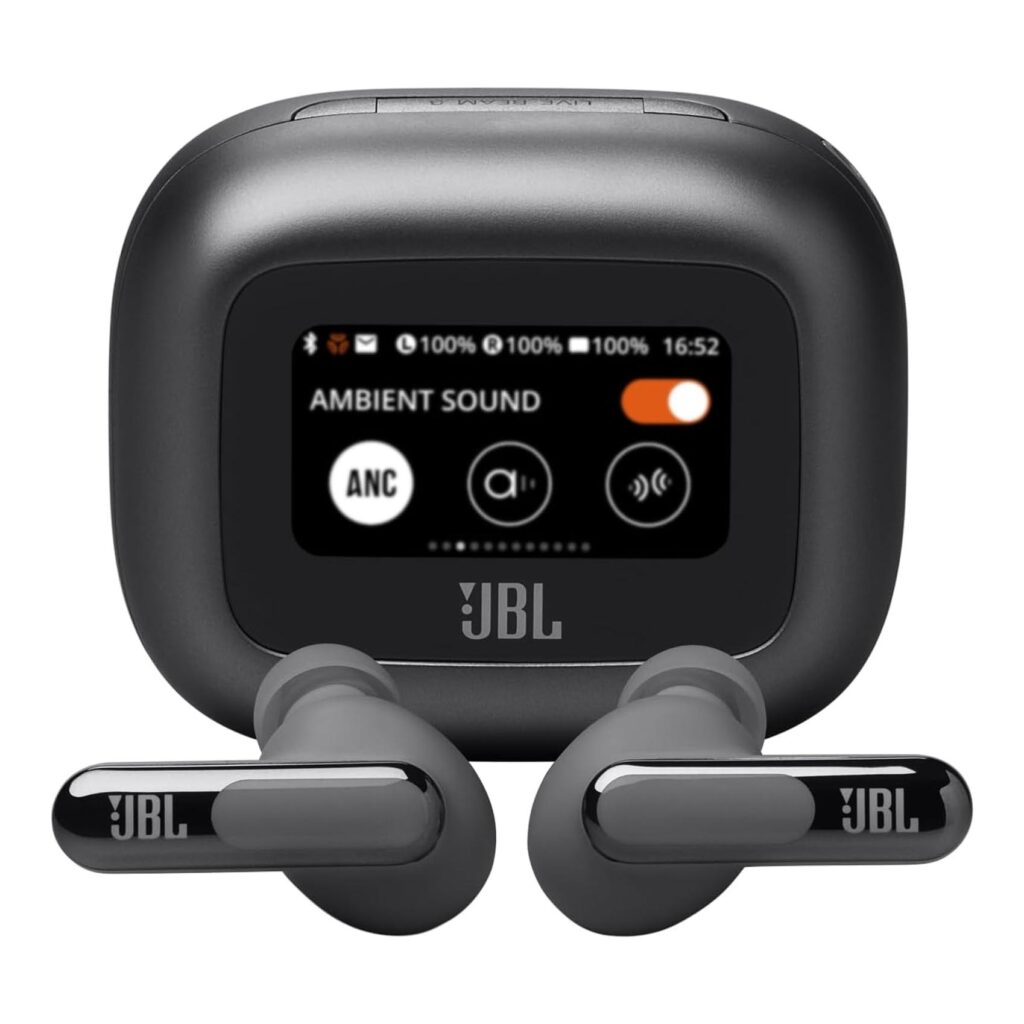
Smart Case Touchscreen: The headline feature of the Live Beam 3 is its Smart Charging Case™ with a touchscreen display. It’s not just for charging – it’s like a mini control panel for your earbuds. With a tap or swipe on the case’s screen, you can adjust key settings like volume, playback, ANC mode, and more without pulling out your phone. Toggle noise cancelling, change a track, see all your battery levels, all while your phone is tucked away. You can also cycle through EQ presets or activate Ambient Aware (transparency mode) from the case menu. The idea is true phone-free control, which is especially handy for athletes who might pair the buds with a smartwatch, or for anyone who often finds it cumbersome to use an app for simple changes. The case’s display is about 1.45 inches and high-res enough for clear visibility. Impressively, JBL implemented this without huge sacrifice to case size – it’s a bit larger than a standard case but still pocketable. This smart case concept garnered a lot of attention as it’s the first of its kind; it feels like having a tiny smartphone interface just for your earbuds.
Hands-On Control & Features: Beyond the case, the Live Beam 3 buds themselves have touch controls on the earbuds and also support popular voice assistants (Google, Alexa, or Siri depending on device) for hands-free operation. But what sets them apart is how fully you can customize and control features directly. You can set the EQ, set an auto-off timer (say you plan on falling asleep with them in), and customize the background for a fun personal touch. The Live Beam 3 includes Adaptive Noise Cancelling that adjusts to your surroundings, and Ambient Aware and TalkThru modes so you can hear your surroundings or have a quick convo without removing the buds. Notably, these earbuds support Bluetooth multipoint, allowing connection to two devices at once (e.g., laptop and phone) – you can be listening to music on your laptop and seamlessly take a call from your phone. And with 6 beamforming microphones, call quality is a selling point; your voice comes through clearly even in noisy settings, while background noise is reduced (great for phone-free calls if your phone is in a bag, you can answer with a tap on the case or buds). The earbuds are also IP55 rated for dust and water resistance, meaning they’re a great option for light to moderate exercise.
Fit & Comfort: These are a stemmed design very similar to Galaxy buds or AirPods. They are slightly larger in body however with softer edges than AirPods so these may make a good alternative if you find Apple’s offering a tad bit uncomfortable. They tend to stay in place for light to moderate exercise.
Battery Life: The Live Beam 3 excels in battery longevity. You get up to 12 hours on the earbuds themselves (with ANC off; around 8-10 hours with ANC on, which is still excellent). The smart case provides an additional 36 hours or so, for a total of up to 48 hours of playback on a full charge. These numbers are among the best in the industry – multi-day use on a single charge is entirely feasible. For example, they significantly outlast AirPods Pro (6h/30h) or Sony XM5 (8h/24h) per charge. Even with heavy use, I only had to charge the case once a week. The case supports wireless charging in addition to USB-C, adding convenience. A quick charge feature is present too: approximately 15 minutes of charging can yield around 4 hours (enough for a lengthy workout or commute). Considering the case’s additional electronics (touchscreen), JBL did a good job ensuring it doesn’t drain the case battery quickly – the screen shuts off automatically (and has a screen lock) when not in use.
Sound Quality: JBL is known for a crowd-pleasing “Signature Sound”, and the Live Beam 3 delivers a punchy, dynamic audio profile. Out of the box, they tend to have an emphasized bass, solid mids, and clear highs. This tuning works great for most genres and while the bass is very present it’s not quite as thumpy as higher end earbuds. That said, because JBL includes both a handful of EQ presets and hi-res audio support, you can tweak the sound to your liking. When it comes to detail and clarity, these hold their own in the upper midrange class of earbuds: you’ll hear crisp vocals and enough detail in instruments for enjoyable critical listening, though true audiophile-grade buds will surpass them in refinement (and cost). The addition of Spatial Audio support means you can create a more immersive listening experience when watching movies or playing games. In practice, the “movie” setting made vocals sound like they were coming from multiple sources which I suppose is supposed to make the soundstage seem wider as if you’re in a movie theater.
Drawbacks: The inclusion of the smart case and all its tech does mean the case is a bit bulkier and cost is higher than average. The price of $199 (can now be found for $149) at launch positions these at the premium end of JBL’s lineup (though still cheaper than some flagship ANC earbuds). If you’re not someone who’d utilize the touchscreen case often, you might find yourself paying for a feature you don’t use. Also, while the case control is very cool, it can be a bit fiddly until you get used to it – the screen is small, so not every action is as instant as on a phone app; some might still prefer using their phone for detailed settings. There’s also a slight delay when controlling tracks through the case. These earbuds do a lot, which means the app and interface have many options – it can be a little overwhelming for users who just want simplicity. In contrast to, say, AirPods which do a lot of thinking for you, the JBL Live Beam 3 invite you to tweak and interact. For most tech enthusiasts this is a plus, but some casual users might find it overkill.
Best Suited For: Tech-savvy users and multitaskers who love the idea of controlling earbuds directly and having loads of features. If you often find yourself without your phone in hand – maybe you leave your phone in a locker while exercising, or you’re a commuter who sometimes stows your phone in a bag – the Live Beam 3 let you manage your listening experience from the case. They’re great for students too; imagine being in class and quietly adjusting volume or turning on ANC from the case in your pocket rather than pulling out your phone. Also, travelers will appreciate the long battery and the ability to quickly change settings on the fly (airplane announcement? flip to Ambient mode on the case; want quiet? turn the ANC on). Those who use multiple devices (say a work laptop and personal phone) will love the multipoint and ease of switching. And of course, if you’re an Android user looking for an AirPods Pro alternative, these offer deep integrations like Google Finder and Audio Switch. They’re also suitable for general use – from workouts (IP55 and secure fit) to Zoom calls (clear 6-mic array) – essentially a Swiss Army knife of earbuds.




